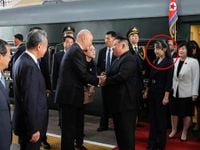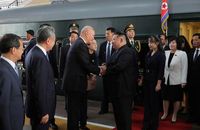North Korean leader Kim Jong Un has once again upended the world’s expectations with a highly publicized visit to Beijing—this time, not alone, but accompanied by his young daughter, Kim Ju Ae. The trip, which began on September 2, 2025, marks not just Kim’s most significant foreign excursion in years, but also the international debut of a possible successor, stirring speculation and intrigue far beyond the Korean Peninsula.
Kim and Ju Ae’s arrival in China was anything but low-key. After a grueling 20-hour journey aboard the family’s iconic green armored train from Pyongyang, they stepped onto the platform at Beijing Railway Station. According to The Washington Post, the pair were greeted by senior Chinese Communist Party official Cai Qi and Chinese Foreign Minister Wang Yi. Ju Ae, dressed in a tailored navy pantsuit with a matching bow in her half-pulled-back hair, stood directly behind her father, projecting a maturity that belied her estimated 12 or 13 years of age.
The timing of their visit was strategic. On September 3, 2025, Kim Jong Un shared center stage at a massive military parade in Tiananmen Square with Chinese President Xi Jinping and Russian President Vladimir Putin. This Victory Day Parade, commemorating 80 years since the end of World War II, was a show of military might—China’s hypersonic weapons, nuclear-capable missiles, and undersea drones on full display, as reported by CNN. Leaders from more than 20 nations, including Iran’s Masoud Pezeshkian and Cuba’s Miguel Diaz-Canel, watched as the event underscored the deepening alignment among Washington’s chief adversaries.
Yet, it was the presence of Kim’s daughter that truly captured the world’s attention. Since her public debut in 2022 at the launch of an intercontinental ballistic missile, Kim Ju Ae’s profile has risen steadily. North Korean state media, while never officially confirming her name, have referred to her as “beloved” and “respected.” The assumption that she is Kim Ju Ae stems from former NBA star Dennis Rodman, who, after a 2013 trip to Pyongyang, recalled holding Kim’s baby daughter and speaking with her mother, Ri Sol Ju. South Korean intelligence officials believe Ju Ae was born in 2013 and has two siblings: an older brother and a younger child whose gender remains unknown.
From that first missile launch—where she appeared in a white coat and red shoes, holding her father’s hand as they watched a rocket soar—Ju Ae’s appearances have multiplied. She’s been seen at missile tests, military parades, and even the April 2025 launch of a naval destroyer, an event hailed as a milestone in expanding North Korea’s nuclear arsenal. According to Associated Press, she has also attended cultural and economic milestones, such as the opening of a beach resort in June 2025 and a visit to the Wonsan Kalma coastal tourist area, where she was photographed in a white ensemble and beige heels.
This public curation of Ju Ae’s image has not gone unnoticed. Early appearances showed her in childlike clothing, but more recent outings feature tailored coats and suits, signaling a deliberate effort to emphasize her maturity. In some cases, generals have been shown kneeling before her—a gesture once reserved exclusively for Kim Jong Un himself. As SOPA Images reported, she has increasingly replaced her mother and aunt as the most visible female figure in the Kim dynasty’s public narrative.
The question on everyone’s mind: is Kim Ju Ae being groomed as the next leader of North Korea? The answer is complicated. South Korea’s National Intelligence Service, in a 2024 assessment, identified her as the likely successor, citing her growing public role and the state protocols accorded to her. However, they also noted that Kim Jong Un, at 41, is still relatively young and has other children, leaving room for multiple succession scenarios. The secrecy surrounding North Korea’s leadership transitions only fuels further speculation.
Traditionally, North Korea’s power structure has been staunchly patriarchal. Since its founding in 1948, only male members of the Kim family have held the country’s highest office. Kim Il Sung, the state’s founder, passed power to his son Kim Jong Il, who in turn was succeeded by Kim Jong Un in 2011. Experts have pointed out that this male-dominated precedent makes Ju Ae’s rise all the more remarkable—and potentially controversial. “While it may not have much impact on his policy decisions in the long run, the fact that Kim Jong Un has opened doors to some women is particularly striking given the historically male representation of power and politics in North Korea,” noted 38 North, a project dedicated to North Korean affairs.
Still, signs of a possible shift abound. Foreign Minister Choe Son Hui, one of the regime’s most powerful women, accompanied Kim and Ju Ae to Beijing, as reported by The Korea Times. Five years ago, Kim’s sister, Kim Yo Jong, was widely discussed as a potential successor after leading a campaign against South Korea. Yet, as Rachel Minyoung Lee, a senior fellow at the Stimson Center, told The Washington Post, “It’s hard to say because we’ve never had the situation before where they brought out a young Kim. So it is hard to compare … but I don’t know that that’s enough to say that this is part of the succession campaign.” Lee suggested that Kim might simply be giving his daughter exposure to the world or trying to appear more relatable as a leader.
Others are more convinced. Cheong Seong-chang of the Sejong Institute told The New York Times that bringing Ju Ae to China was “a strong signal to the world that she is going to be his successor.” Michael Madden, a North Korea leadership expert at the Stimson Center, echoed this sentiment in The Guardian: “She is getting practical protocol experience which should serve her well as North Korea’s next leader or a core elite.”
Beyond succession, Ju Ae’s growing presence may also serve a symbolic role. As Korea analyst Donald Southerton explained, “Each photo, parade walk and salute I see as a carefully staged story of succession, legitimacy and continuity for the Kim dynasty.” Observers have speculated that Kim Jong Un’s own health—South Korean intelligence has cited obesity and heart concerns—could be driving the urgency behind Ju Ae’s elevation, though there is no official confirmation of any immediate risk to the leader’s wellbeing.
For now, North Korea’s state media remain silent on any formal succession plan. The world, meanwhile, is left to interpret the carefully choreographed appearances of Kim Ju Ae, a young girl thrust onto the global stage as both a symbol of continuity and a possible harbinger of change in the world’s most secretive regime.






